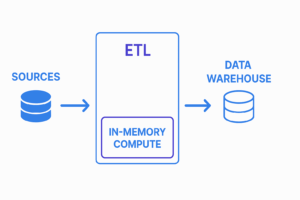IOblend: Simplifying Slowly Changing Dimensions for Real-Time Analytics
In the dynamic world of data analytics, information is constantly evolving. Businesses rely on accurate and up-to-date data to make informed decisions, which is why understanding and managing slowly changing dimensions (SCDs) is crucial. SCDs refer to the way data changes over time and how these changes are captured and stored in data warehouses or databases.
In this blog, we’ll explore the concept of slowly changing dimensions, the types that exist, and the common approaches to dealing with the issues they present. Furthermore, we’ll delve into real-world examples of SCDs in various industry settings and discuss their relevance in the context of real-time analytics.
What Are Slowly Changing Dimensions?
Slowly changing dimensions are attributes within a data structure that change over time, but not at a constant rate. When dealing with SCDs, it’s important to distinguish between different types of changes to handle them effectively. There are three primary types of slowly changing dimensions:
Type 1 SCD (Static): In this type, changes to a dimension attribute are not tracked. When a change occurs, the existing value is simply overwritten with the new value, erasing the history. This approach is suitable when historical data is not relevant or when storage constraints are a concern.
Type 2 SCD (Historical): In Type 2 SCDs, a new record is created for each change in dimension attributes, preserving historical data. This approach allows for tracking changes over time and is commonly used when historical context is critical, such as in customer or product histories.
Type 3 SCD (Partial Historical): Type 3 SCDs maintain a limited history of changes by adding new columns to the dimension table to store both the current and previous values. This approach strikes a balance between preserving history and minimizing data storage.
Here are some common examples of SCD that can alter over time:
Customer dimension: Customer name, address, phone number, email address
Product dimension: Product name, description, price, SKU
Employee dimension: Employee name, title, department, manager
Order dimension: Order date, order amount, shipping address
Time dimension: Date, time, day of week, month, year
Common Approaches to Managing Slowly Changing Dimensions
ETL (Extract, Transform, Load): ETL processes are often used to handle SCDs by extracting data from source systems, transforming it to match the desired structure, and loading it into a data warehouse or database. ETL tools can help automate the process of detecting and managing changes in dimensions.
Database Triggers: Database triggers can be used to capture changes in real-time as they occur. When a change happens, a trigger is fired, and the new data is stored alongside the existing data, allowing for historical tracking.
Versioning and Timestamps: Another approach is to add versioning or timestamp columns to the dimension table. This method allows for the easy identification of the latest version of a dimension and enables efficient querying of historical data.
Real-World Examples of Slowly Changing Dimensions
Retail Industry: In the retail sector, product attributes like price, category, and manufacturer may change over time. Type 2 SCDs can be used to track these changes, ensuring that historical sales data remains accurate for reporting and analysis.
Healthcare: In healthcare, patient information such as address, insurance, or medical history can change. Type 2 SCDs help healthcare organizations maintain accurate patient records and track changes over time.
Financial Services: In the financial sector, customer information, account status, and credit limits may change. Type 2 SCDs are essential for maintaining a historical record of customer profiles and account data for regulatory compliance and customer relationship management.
Slowly Changing Dimensions in Real-Time Analytics
In the context of real-time analytics, the challenges of managing SCDs become even more complex. Real-time analytics demand that data be up-to-date and readily available for analysis as soon as it changes. To address this, organizations can employ the following strategies:
Change Data Capture (CDC): Implement CDC mechanisms to detect and capture changes in dimension data in real time. This ensures that updated data is immediately available for analysis without waiting for traditional batch ETL processes.
Streaming Data Pipelines: Utilize streaming data pipelines to process and update dimension data as it arrives. Technologies like Apache Spark and Apache Flink can be valuable in achieving real-time updates.
Data Warehousing Solutions: Consider using modern cloud-based data warehousing solutions that support both real-time and batch processing. These platforms offer tools and features designed to handle SCDs efficiently.
Slowly Changing Dimensions with IOblend
In the ever-evolving landscape of data analytics, handling slowly changing dimensions (SCDs) in real-time scenarios demands cutting-edge solutions to do it properly. IOblend was designed to seamlessly manage SCDs automatically and empower organizations in their quest for real-time insights. In this section, we’ll explore how IOblend tackles SCDs in the context of real-time analytics, complementing the strategies mentioned earlier.
IOblend leverages advanced CDC mechanisms to detect and capture changes in dimension data in real-time. Here’s how IOblend handles SCDs:
Instant Detection: IOblend constantly monitors data sources for changes, ensuring that as soon as a dimension attribute is modified, it is detected in real-time. The system can be configured to show (and process) new and historic records as required.
Efficient Data Propagation: Once a change is detected, IOblend efficiently propagates the updated data to the target systems, such as data warehouses or analytics platforms, without the need for traditional batch ETL processes.
Granular Control: IOblend offers granular control over how SCDs are managed. Users can configure the system to apply different SCD types (Type 1, Type 2, or Type 3) based on their specific requirements.
IOblend’s streaming data pipelines provide a robust foundation for handling SCDs in real-time analytics:
High Throughput: IOblend’s pipelines are designed to handle high volumes of data with low latency, ensuring that dimension updates are processed as quickly as they occur.
Transformation Flexibility: Users can easily apply transformations to the incoming data to meet their business needs, while resting assured IOblend is managing SCDs through versioning and timestamps from source to sink (and retaining the record of all changes throughout).
Data Warehousing Solutions with IOblend
IOblend seamlessly integrates with modern cloud-based data warehousing solutions, enhancing their capabilities for SCD management:
Cloud Integration: IOblend supports integration with popular cloud platforms, such as AWS, Azure, and Google Cloud, making it easier for organizations to leverage the scalability and flexibility of these platforms for real-time analytics. IOblend is a proud ISV partner of Microsoft and Snowflake.
Data Quality Assurance: IOblend includes robust data quality checks and validations, ensuring that dimension data changes are accurate and complete before they are incorporated into the data warehouse – all as part of the full production grade real-time ETL.
SCDs are a fundamental aspect of data management
Understanding the types of SCDs and employing appropriate strategies for their management is essential for accurate reporting and analysis. In the age of real-time analytics, organizations must adapt their data management practices ensuring that SCDs do not hinder their ability to make informed decisions based on the latest information. By implementing the right tools and approaches, businesses can maintain a comprehensive view of their data, enabling them to stay agile and responsive in a rapidly changing world.
IOblend serves as a game-changing tool for organizations seeking to harness the power of real-time analytics while effectively managing slowly changing dimensions. By combining advanced CDC mechanisms, streaming data pipelines, and seamless integration with modern data warehousing solutions, IOblend empowers businesses to stay ahead in a rapidly changing data world. With IOblend, SCDs are no longer obstacles but opportunities to gain valuable insights and make data-driven decisions in real time easily and cost-effectively.
In the fast-paced realm of real-time analytics, managing slowly changing dimensions (SCDs) is a complex yet critical task, essential for ensuring accurate and up-to-date data analysis. SCDs represent data attributes that evolve over time but not at a fixed rate, and their efficient management is crucial for businesses to make informed decisions. Strategies like ETL processes, database triggers, and versioning are traditionally employed to handle SCDs. However, in real-time analytics, these challenges intensify, necessitating advanced solutions like Change Data Capture (CDC) and streaming data pipelines for instant detection and efficient data propagation. IOblend addresses these complexities by offering seamless management of SCDs in real-time scenarios. It leverages CDC mechanisms for real-time detection and updates, provides granular control over SCD types, and ensures high throughput and transformation flexibility in its streaming data pipelines. This comprehensive approach enables businesses to effectively manage SCDs, maintain data integrity, and leverage real-time analytics for agile and informed decision-making.

PoC to Production: Accelerating AI Deployment with IOblend
PoC to Production: Accelerating AI Deployment with IOblend 💭 Did You Know? While a staggering 92% of companies are actively experimenting with Artificial Intelligence, a mere 1% ever achieve full maturity in deploying AI solutions at scale. The AI Production Journey A Proof of Concept (PoC) in AI serves as a small-scale, experimental project designed

AI in Healthcare with Smart Data Pipelines
AI in Healthcare: Powering Progress with Smart Data Pipelines 💉 Did you know? Hospitals in the UK alone produce an astonishing 50 petabytes of data per year, more than double the data managed by the US Library of Congress in 2022! What are Data Pipelines for AI Model Training? In the context of healthcare, this means

The Urgency of Now: Real-Time Data in Analytics
The Urgency of Now: Real-Time Data in Analytics ✈️ Did you know? Every minute of delay in airline operations can cost as much as £100 per minute for a single aircraft. With thousands of flights daily, those minutes add up fast. Just like in aviation, in data analytics, even small delays can lead to big

Still Confused in 2025? AI, ML & Data Science Explained
Still Confused in 2025? AI, ML & Data Science Explained…finally It seems everyone in business circles talks about these days. AI will solve all our business challenges and make/save us a ton of money. AI will replace manual labour with clever agents. It will change the world and our business will be at the forefront

Beyond Spreadsheets: The CFO’s Path to Data-Driven Decisions
Beyond Spreadsheets: The CFO’s Path to Data-Driven Decisions 📊 Did you know? Companies leveraging data-driven insights consistently report a significant uplift in profitability – often exceeding 20%. That’s not just a marginal gain; it’s a game-changer. The Data-Driven CFO The modern Chief Financial Officer operates in a world awash with data. No longer solely focused

Shift Left: Unleashing Data Power with In-Memory Processing
Mind the Gap: Bridging Data Shift Left: Unleashing Data Power with In-Memory Processing 💻 Did you know? Organisations that implement shift-left strategies can experience up to a 30% reduction in compute costs by cleaning data at the source. The Essence of Shifting Left Shifting data compute and governance “left” essentially means moving these processes closer

